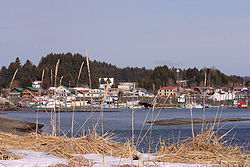This article needs additional citations for verification .(July 2016) |
Kenai Peninsula Borough, Alaska | |
|---|---|
Left to right, from top: Overhead view of Homer and Kachemak Bay, sunrise on Kachemak Bay, view of Kenai Lake, the Coral Seymour Memorial Ballpark, view of Mount Alice at Seward, view of the Kenai Mountains | |
 Location within the U.S. state of Alaska | |
 Alaska's location within the U.S. | |
| Coordinates: 60°25′00″N151°15′00″W / 60.416666666667°N 151.25°W | |
| Country | |
| State | |
| Incorporated | January 1, 1964 [1] [2] |
| Named after | Kenai Peninsula |
| Seat | Soldotna |
| Largest city | Kalifornsky |
| Area | |
• Total | 24,752 sq mi (64,110 km2) |
| • Land | 16,075 sq mi (41,630 km2) |
| • Water | 8,677 sq mi (22,470 km2) 35.1% |
| Population (2020) | |
• Total | 58,799 |
• Estimate (2024) | 61,259 |
| • Density | 3.6578/sq mi (1.4123/km2) |
| Time zone | UTC−9 (Alaska) |
| • Summer (DST) | UTC−8 (ADT) |
| Congressional district | At-large |
| Website | www |
Kenai Peninsula Borough is a borough in the U.S. state of Alaska. As of the 2020 census, the population was 58,799, up from 55,400 in 2010. [3] The borough seat is Soldotna, [4] the largest city is Kenai, and the most populated community is the census-designated place of Kalifornsky.
Contents
- Geography
- Adjacent boroughs and census areas
- National protected areas
- Ecology
- Demographics
- 2020 census
- 2000 census
- Government and infrastructure
- Communities
- Cities
- Census-designated places
- Unincorporated communities
- Ghost town
- Education
- See also
- References
- External links
The borough includes most of the Kenai Peninsula and a large area of the mainland of Alaska on the opposite side of Cook Inlet.










